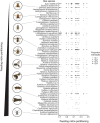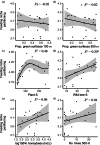Low resource availability drives feeding niche partitioning between wild bees and honeybees in a European city
- PMID: 36054537
- PMCID: PMC10077915
- DOI: 10.1002/eap.2727
Low resource availability drives feeding niche partitioning between wild bees and honeybees in a European city
Abstract
Cities are socioecological systems that filter and select species, therefore establishing unique species assemblages and biotic interactions. Urban ecosystems can host richer wild bee communities than highly intensified agricultural areas, specifically in resource-rich urban green spaces such as allotments and family gardens. At the same time, urban beekeeping has boomed in many European cities, raising concerns that the fast addition of a large number of managed bees could deplete the existing floral resources, triggering competition between wild bees and honeybees. Here, we studied the interplay between resource availability and the number of honeybees at local and landscape scales and how this relationship influences wild bee diversity. We collected wild bees and honeybees in a pollination experiment using four standardized plant species with distinct floral morphologies. We performed the experiment in 23 urban gardens in the city of Zurich (Switzerland), distributed along gradients of urban and local management intensity, and measured functional traits related to resource use. At each site, we quantified the feeding niche partitioning (calculated as the average distance in the multidimensional trait space) between the wild bee community and the honeybee population. Using multilevel structural equation models (SEM), we tested direct and indirect effects of resource availability, urban beekeeping, and wild bees on the community feeding niche partitioning. We found an increase in feeding niche partitioning with increasing wild bee species richness. Moreover, feeding niche partitioning tended to increase in experimental sites with lower resource availability at the landscape scale, which had lower abundances of honeybees. However, beekeeping intensity at the local and landscape scales did not directly influence community feeding niche partitioning or wild bee species richness. In addition, wild bee species richness was positively influenced by local resource availability, whereas local honeybee abundance was positively affected by landscape resource availability. Overall, these results suggest that direct competition for resources was not a main driver of the wild bee community. Due to the key role of resource availability in maintaining a diverse bee community, our study encourages cities to monitor floral resources to better manage urban beekeeping and help support urban pollinators.
Keywords: competition; intraspecific trait variability; pollinator; species interaction; urban biodiversity; urbanization.
© 2022 The Authors. Ecological Applications published by Wiley Periodicals LLC on behalf of The Ecological Society of America.
Conflict of interest statement
The authors declare no conflict of interest.
Figures






Similar articles
-
Decline in wild bee species richness associated with honey bee (Apis mellifera L.) abundance in an urban ecosystem.PeerJ. 2023 Feb 3;11:e14699. doi: 10.7717/peerj.14699. eCollection 2023. PeerJ. 2023. PMID: 36755869 Free PMC article.
-
Vegetation complexity and nesting resource availability predict bee diversity and functional traits in community gardens.Ecol Appl. 2023 Mar;33(2):e2759. doi: 10.1002/eap.2759. Epub 2022 Dec 19. Ecol Appl. 2023. PMID: 36217895
-
Pollinator richness, pollination networks, and diet adjustment along local and landscape gradients of resource diversity.Ecol Appl. 2022 Sep;32(6):e2634. doi: 10.1002/eap.2634. Epub 2022 Jun 26. Ecol Appl. 2022. PMID: 35403772 Free PMC article.
-
Opportunities and threats for pollinator conservation in global towns and cities.Curr Opin Insect Sci. 2020 Apr;38:63-71. doi: 10.1016/j.cois.2020.01.006. Epub 2020 Jan 28. Curr Opin Insect Sci. 2020. PMID: 32126514 Review.
-
Bees in the city: Findings from a scoping review and recommendations for urban planning.Ambio. 2024 Sep;53(9):1281-1295. doi: 10.1007/s13280-024-02028-1. Epub 2024 May 20. Ambio. 2024. PMID: 38767748 Free PMC article.
Cited by
-
Urban bumblebees diversify their foraging strategy to maintain nutrient intake.Proc Biol Sci. 2025 May;292(2047):20250639. doi: 10.1098/rspb.2025.0639. Epub 2025 May 21. Proc Biol Sci. 2025. PMID: 40393485 Free PMC article.
-
Do local and landscape context affect the attractiveness of flower gardens to bees?PLoS One. 2024 Sep 4;19(9):e0309000. doi: 10.1371/journal.pone.0309000. eCollection 2024. PLoS One. 2024. PMID: 39231092 Free PMC article.
-
Investigation and Study on the Biology and Morphology of Apis florea and Apis dorsata in Southern China.Life (Basel). 2025 Feb 21;15(3):341. doi: 10.3390/life15030341. Life (Basel). 2025. PMID: 40141687 Free PMC article.
-
Neglecting non-bee pollinators may lead to substantial underestimation of competition risk among pollinators.Curr Res Insect Sci. 2024 Aug 2;6:100093. doi: 10.1016/j.cris.2024.100093. eCollection 2024. Curr Res Insect Sci. 2024. PMID: 39220234 Free PMC article. Review.
-
Examining Honeybee (Apis mellifera) Dominance Patterns Within Urban Bee Communities Worldwide.Ecol Evol. 2025 Aug 13;15(8):e71979. doi: 10.1002/ece3.71979. eCollection 2025 Aug. Ecol Evol. 2025. PMID: 40809827 Free PMC article.
References
-
- Albert, C. H. , de Bello F., Boulangeat I., Pellet G., Lavorel S., and Thuiller W.. 2012. “On the Importance of Intraspecific Variability for the Quantification of Functional Diversity.” Oikos 121: 116–26.
-
- Alberti, M. 2015. “Eco‐Evolutionary Dynamics in an Urbanizing Planet.” Trends in Ecology & Evolution 30: 114–26. - PubMed
-
- Baldock, K. C. R. 2020. “Opportunities and Threats for Pollinator Conservation in Global Towns and Cities.” Current Opinion in Insect Science 38: 63–71. - PubMed
-
- Baldock, K. C. R. , Goddard M. A., Hicks D. M., Kunin W. E., Mitschunas N., Osgathorpe L. M., Potts S. G., et al. 2015. “Where is the UK's Pollinator Biodiversity? The Importance of Urban Areas for Flower‐Visiting Insects.” Proceedings of the Royal Society B: Biological Sciences 282(1803): 20142849. 10.1098/rspb.2014.2849. - DOI - PMC - PubMed
Publication types
MeSH terms
LinkOut - more resources
Full Text Sources

